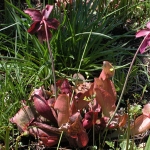| Common Name: |
Pitcher Plant |
| Other Names: |
Indian Jug, Purple Pitcher Plant |
| Botanical Name: |
Sarracenia purpurea |
| Genus: |
Sarracenia |
| Family: |
Sarraceniaceae |
| Distribution: |
Its range includes the Eastern seaboard and Gulf Coast of the United States, the Great Lakes region, all of Canada (except Nunavut and Yukon), Washington state, and Alaska. That makes it the most common and broadly distributed pitcher plant, as well as the only member of the genus that inhabits cold temperate climates. The species is the floral emblem of the Canadian province of Newfoundland and Labrador. The species was introduced into bogs in parts of Ireland, where it has proliferated.
It is an introduced and naturalized species in northern California. It is found in habitats of the native carnivorous species Darlingtonia californica, in the Klamath Mountains and northern Sierra Nevada.
|
| Parts Used: |
Roots |
| Chemical Constituents: |
Resin
Yellow dye
|
| Known Effects: |
Irritates gastrointestinal tract
Has diuretic properties
|
| Possible Additional Effects: |
May treat constipation
May treat indigestion
|
| Warnings and Precautions: |
Don't take if you:
Are pregnant, think you may be pregnant, or plan pregnancy in the near future.
Consult your doctor if you:
Take this herb for any medical problem that doesn't improve in 2 weeks (There may be safer, more effective treatments.)
Take any medicinal drugs or herbs including aspirin, laxatives, cold and cough remedies, antacids, vitamins, minerals, amino acids, supplements, other prescription or non-prescription drugs.
Pregnancy:
Don't use unless prescribed by your doctor.
Breastfeeding:
Don't use unless prescribed by your doctor.
Infants and Children:
Treating infants and children under 2 with any herbal preparation is hazardous.
Others:
None are expected if you are beyond childhood, under 45, not pregnant, basically healthy, take it only for a short time and do not exceed manufacturer's recommended dose.
Storage:
Store in cool, dry area away from direct light, but don't freeze.
Store safely out of reach of children.
Don't store in bathroom medicine cabinet. Heat and moisture may change the action of the herb.
Safe Dosage:
Consult your doctor for the appropriate dose for your condition.
|
| Bibliography: |
Wikipedia Article—Sarracenia purpurea
Vitamins, Herbs, Minerals & Supplements The Complete Guide by H. Winter Griffith, MD Copyright©1998 Fisher Books pg 414 |

